Role of protein phosphatase 1 in dephosphorylation of Ebola virus VP30 protein and its targeting for the inhibition of viral transcription
- PMID: 24936058
- PMCID: PMC4132779
- DOI: 10.1074/jbc.M114.575050
Role of protein phosphatase 1 in dephosphorylation of Ebola virus VP30 protein and its targeting for the inhibition of viral transcription
Abstract
The filovirus Ebola (EBOV) causes the most severe hemorrhagic fever known. The EBOV RNA-dependent polymerase complex includes a filovirus-specific VP30, which is critical for the transcriptional but not replication activity of EBOV polymerase; to support transcription, VP30 must be in a dephosphorylated form. Here we show that EBOV VP30 is phosphorylated not only at the N-terminal serine clusters identified previously but also at the threonine residues at positions 143 and 146. We also show that host cell protein phosphatase 1 (PP1) controls VP30 dephosphorylation because expression of a PP1-binding peptide cdNIPP1 increased VP30 phosphorylation. Moreover, targeting PP1 mRNA by shRNA resulted in the overexpression of SIPP1, a cytoplasm-shuttling regulatory subunit of PP1, and increased EBOV transcription, suggesting that cytoplasmic accumulation of PP1 induces EBOV transcription. Furthermore, we developed a small molecule compound, 1E7-03, that targeted a non-catalytic site of PP1 and increased VP30 dephosphorylation. The compound inhibited the transcription but increased replication of the viral genome and completely suppressed replication of EBOV in cultured cells. Finally, mutations of Thr(143) and Thr(146) of VP30 significantly inhibited EBOV transcription and strongly induced VP30 phosphorylation in the N-terminal Ser residues 29-46, suggesting a novel mechanism of regulation of VP30 phosphorylation. Our findings suggest that targeting PP1 with small molecules is a feasible approach to achieve dysregulation of the EBOV polymerase activity. This novel approach may be used for the development of antivirals against EBOV and other filovirus species.
Keywords: Ebola Virus; Phosphoprotein Phosphatase 1 (PP1); Small Molecule; Transcription; Viral Replication.
© 2014 by The American Society for Biochemistry and Molecular Biology, Inc.
Figures
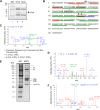
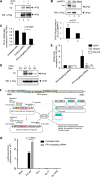
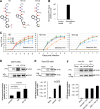

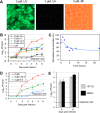

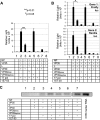
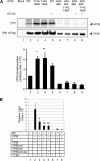

Similar articles
-
Serine-Arginine Protein Kinase 1 Regulates Ebola Virus Transcription.mBio. 2020 Feb 25;11(1):e02565-19. doi: 10.1128/mBio.02565-19. mBio. 2020. PMID: 32098814 Free PMC article.
-
Phosphorylated VP30 of Marburg Virus Is a Repressor of Transcription.J Virol. 2018 Oct 12;92(21):e00426-18. doi: 10.1128/JVI.00426-18. Print 2018 Nov 1. J Virol. 2018. PMID: 30135121 Free PMC article.
-
Protein Phosphatase 1-Targeting Small-Molecule C31 Inhibits Ebola Virus Replication.J Infect Dis. 2018 Nov 22;218(suppl_5):S627-S635. doi: 10.1093/infdis/jiy422. J Infect Dis. 2018. PMID: 30169869 Free PMC article.
-
Virus and host interactions critical for filoviral RNA synthesis as therapeutic targets.Antiviral Res. 2019 Feb;162:90-100. doi: 10.1016/j.antiviral.2018.12.006. Epub 2018 Dec 11. Antiviral Res. 2019. PMID: 30550800 Free PMC article. Review.
-
Filovirus proteins for antiviral drug discovery: Structure/function bases of the replication cycle.Antiviral Res. 2017 May;141:48-61. doi: 10.1016/j.antiviral.2017.02.004. Epub 2017 Feb 10. Antiviral Res. 2017. PMID: 28192094 Review.
Cited by
-
Phosphorylation of Human Metapneumovirus M2-1 Protein Upregulates Viral Replication and Pathogenesis.J Virol. 2016 Jul 27;90(16):7323-7338. doi: 10.1128/JVI.00755-16. Print 2016 Aug 15. J Virol. 2016. PMID: 27252537 Free PMC article.
-
Defining Distinct RNA-Protein Interactomes of SARS-CoV-2 Genomic and Subgenomic RNAs.J Proteome Res. 2024 Jan 5;23(1):149-160. doi: 10.1021/acs.jproteome.3c00506. Epub 2023 Dec 3. J Proteome Res. 2024. PMID: 38043095 Free PMC article.
-
RSV hijacks cellular protein phosphatase 1 to regulate M2-1 phosphorylation and viral transcription.PLoS Pathog. 2018 Feb 28;14(3):e1006920. doi: 10.1371/journal.ppat.1006920. eCollection 2018 Mar. PLoS Pathog. 2018. PMID: 29489893 Free PMC article.
-
Molecular insights into the Ebola virus life cycle.Nat Microbiol. 2024 Jun;9(6):1417-1426. doi: 10.1038/s41564-024-01703-z. Epub 2024 May 23. Nat Microbiol. 2024. PMID: 38783022 Review.
-
Therapeutics for postexposure treatment of Ebola virus infection.Future Virol. 2015 Mar;10(3):221-232. doi: 10.2217/fvl.14.109. Future Virol. 2015. PMID: 26213559 Free PMC article.
References
-
- Centers for Disease Control and Prevention (2014) Outbreak of Ebola in Guinea, Liberia, and Sierra Leone, Centers for Disease Control and Prevention, Atlanta
-
- Kuhn J. H. (2008) Filoviruses, 1st Ed., pp. 190–251, Springer, New York
Publication types
MeSH terms
Substances
Grants and funding
LinkOut - more resources
Full Text Sources
Other Literature Sources
Medical

